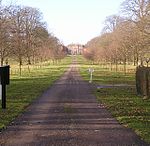Walford Halt railway station
Disused railway stations in HerefordshireFormer Great Western Railway stationsHistory of HerefordshirePages with no open date in Infobox stationRailway stations in Great Britain closed in 1959 ... and 2 more
Railway stations in Great Britain opened in 1931Use British English from April 2017
Walford Halt railway station is a disused halt on the Ross and Monmouth Railway constructed near the Herefordshire village of Walford. It also served the surrounding settlements. Nothing remains of the station. It was located approximately 3 miles and 12 chains along the railway from Ross-on-Wye station.
Excerpt from the Wikipedia article Walford Halt railway station (License: CC BY-SA 3.0, Authors).Walford Halt railway station
Archenfield Road,
Geographical coordinates (GPS) Address External links Nearby Places Show on map
Geographical coordinates (GPS)
| Latitude | Longitude |
|---|---|
| N 51.8819 ° | E -2.6028 ° |
Address
Walford
Archenfield Road
HR9 7TF
England, United Kingdom
Open on Google Maps









